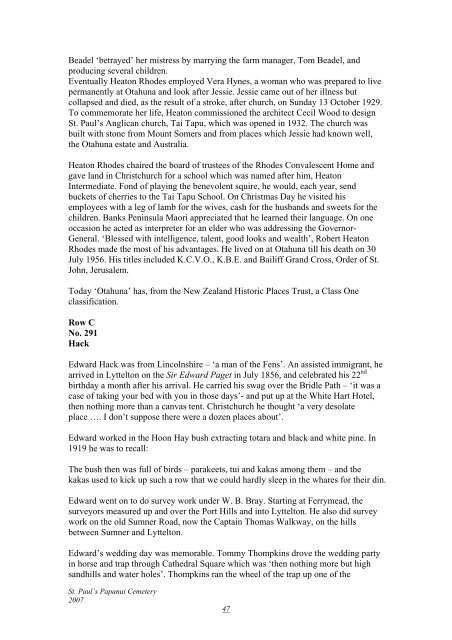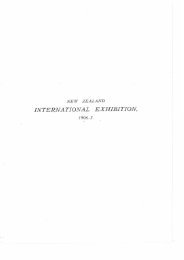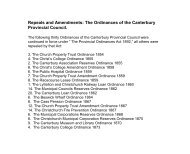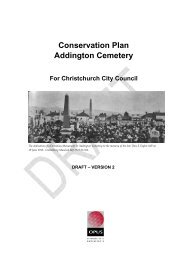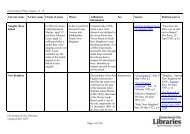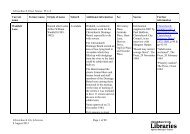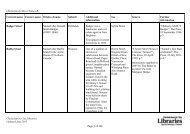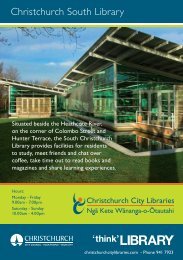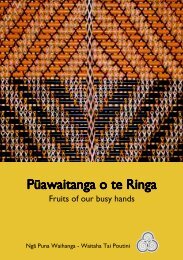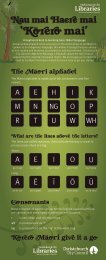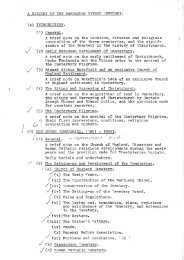St Pauls Papanui Cemetery - Christchurch City Libraries
St Pauls Papanui Cemetery - Christchurch City Libraries
St Pauls Papanui Cemetery - Christchurch City Libraries
Create successful ePaper yourself
Turn your PDF publications into a flip-book with our unique Google optimized e-Paper software.
Beadel ‘betrayed’ her mistress by marrying the farm manager, Tom Beadel, and<br />
producing several children.<br />
Eventually Heaton Rhodes employed Vera Hynes, a woman who was prepared to live<br />
permanently at Otahuna and look after Jessie. Jessie came out of her illness but<br />
collapsed and died, as the result of a stroke, after church, on Sunday 13 October 1929.<br />
To commemorate her life, Heaton commissioned the architect Cecil Wood to design<br />
<strong>St</strong>. Paul’s Anglican church, Tai Tapu, which was opened in 1932. The church was<br />
built with stone from Mount Somers and from places which Jessie had known well,<br />
the Otahuna estate and Australia.<br />
Heaton Rhodes chaired the board of trustees of the Rhodes Convalescent Home and<br />
gave land in <strong>Christchurch</strong> for a school which was named after him, Heaton<br />
Intermediate. Fond of playing the benevolent squire, he would, each year, send<br />
buckets of cherries to the Tai Tapu School. On Christmas Day he visited his<br />
employees with a leg of lamb for the wives, cash for the husbands and sweets for the<br />
children. Banks Peninsula Maori appreciated that he learned their language. On one<br />
occasion he acted as interpreter for an elder who was addressing the Governor-<br />
General. ‘Blessed with intelligence, talent, good looks and wealth’, Robert Heaton<br />
Rhodes made the most of his advantages. He lived on at Otahuna till his death on 30<br />
July 1956. His titles included K.C.V.O., K.B.E. and Bailiff Grand Cross, Order of <strong>St</strong>.<br />
John, Jerusalem.<br />
Today ‘Otahuna’ has, from the New Zealand Historic Places Trust, a Class One<br />
classification.<br />
Row C<br />
No. 291<br />
Hack<br />
Edward Hack was from Lincolnshire – ‘a man of the Fens’. An assisted immigrant, he<br />
arrived in Lyttelton on the Sir Edward Paget in July 1856, and celebrated his 22 nd<br />
birthday a month after his arrival. He carried his swag over the Bridle Path – ‘it was a<br />
case of taking your bed with you in those days’- and put up at the White Hart Hotel,<br />
then nothing more than a canvas tent. <strong>Christchurch</strong> he thought ‘a very desolate<br />
place …. I don’t suppose there were a dozen places about’.<br />
Edward worked in the Hoon Hay bush extracting totara and black and white pine. In<br />
1919 he was to recall:<br />
The bush then was full of birds – parakeets, tui and kakas among them – and the<br />
kakas used to kick up such a row that we could hardly sleep in the whares for their din.<br />
Edward went on to do survey work under W. B. Bray. <strong>St</strong>arting at Ferrymead, the<br />
surveyors measured up and over the Port Hills and into Lyttelton. He also did survey<br />
work on the old Sumner Road, now the Captain Thomas Walkway, on the hills<br />
between Sumner and Lyttelton.<br />
Edward’s wedding day was memorable. Tommy Thompkins drove the wedding party<br />
in horse and trap through Cathedral Square which was ‘then nothing more but high<br />
sandhills and water holes’. Thompkins ran the wheel of the trap up one of the<br />
<strong>St</strong>. Paul’s <strong>Papanui</strong> <strong>Cemetery</strong><br />
2007<br />
47


